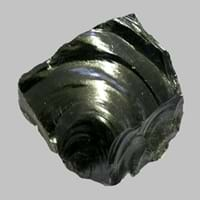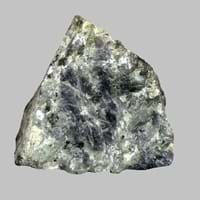Definition
Obsidian is a naturally occurring volcanic glass formed as an extrusive igneous rock. It is produced when felsic lava extruded from a volcano cools rapidly with minimum crystal growth
Anorthosite is a granular igneous rock composed largely of labradorite or plagioclase
Discoverer
Obsius
Unknown
Etymology
From Latin obsidianus, misprint of Obsianus (lapis) (stone) of Obsius
From French anorthose plagioclase + -ite1
Class
Igneous Rocks
Igneous Rocks
Sub-Class
Durable Rock, Medium Hardness Rock
Durable Rock, Medium Hardness Rock
Other Categories
Opaque Rock
Coarse Grained Rock, Opaque Rock
Texture
Glassy
Foliated, Glassy
Color
Black, Blue, Brown, Green, Orange, Red, Tan, Yellow
Black, Bluish - Grey, Brown, Green, Grey, Light Greenish Grey, Pink, White
Durability
Durable
Durable
Appearance
Shiny
Layered, Banded, Veined and Shiny
Interior Uses
Decorative Aggregates, Interior Decoration
Decorative Aggregates, Floor Tiles, Homes, Interior Decoration
Exterior Uses
Garden Decoration
As Building Stone, As Facing Stone, Garden Decoration
Other Architectural Uses
Not Yet Used
Curbing
Construction Industry
Arrowheads, Cutting Tool, Knives, Scrapers, Spear Points
As Dimension Stone, Cement Manufacture, for Road Aggregate
Medical Industry
Surgery
Not Yet Used
Antiquity Uses
Artifacts, Jewellery
Artifacts, Sculpture, Small Figurines
Commercial Uses
Creating Artwork, Mirror, Used in aquariums
Creating Artwork, Curling
Types
Fireworks Obsidian, Mahogany, Sheen Obsidian, Snowflake obsidian and Velvet Peacock Obsidian
Proterozoic Anorthosite and Archean Anorthosite
Features
Blocks negativity, Helps to protect against depression
Generally rough to touch, Is one of the oldest rock
Archaeological Significance
Monuments
Not Yet Used
Not Yet Used
Famous Monuments
Not Applicable
Not Applicable
Sculpture
Not Yet Used
Used
Famous Sculptures
Not Applicable
Not Applicable
Pictographs
Used
Not Used
Petroglyphs
Used
Not Used
Figurines
Not Yet Used
Used
Formation
When the lava is released from volcano, it undergoes a very rapid cooling which freezes the mechanisms of crystallization. The result is a volcanic glass with a uniform smooth texture.
Anorthosite is a phaneritic, intrusive igneous rock which is characterized by a predominance of plagioclase feldspar which is almost 90–100%, and a minimal mafic component.
Mineral Content
Not Available
Amphibole, Clinopyroxene, Ilmenite, Magnetite, Olivine, Orthopyroxene
Compound Content
Aluminium Oxide, CaO, Iron(III) Oxide, FeO, Potassium Oxide, MgO, MnO, Sodium Oxide, Phosphorus Pentoxide, Silicon Dioxide, Titanium Dioxide
Ca, CaO, Chromium(III) Oxide, MgO, Sulfur Trioxide
Types of Metamorphism
Burial Metamorphism, Cataclastic Metamorphism, Contact Metamorphism
Cataclastic Metamorphism, Contact Metamorphism
Types of Weathering
Biological Weathering, Chemical Weathering, Mechanical Weathering
Biological Weathering
Types of Erosion
Chemical Erosion, Coastal Erosion, Glacier Erosion
Chemical Erosion, Wind Erosion
Grain Size
Not Applicable
Coarse Grained
Fracture
Conchoidal
Irregular
Porosity
Very Less Porous
Less Porous
Luster
Vitreous
Pearly to Subvitreous
Compressive Strength
Not Available
Cleavage
Non-Existent
Irregular
Toughness
Not Available
Not Available
Specific Gravity
2.6-2.7
2.62-2.82
Transparency
Translucent
Translucent
Density
2.6 g/cm3
2.7-4 g/cm3
Resistance
Heat Resistant, Impact Resistant
Heat Resistant, Impact Resistant, Pressure Resistant, Scratch Resistant, Wear Resistant
Deposits in Eastern Continents
Asia
Afghanistan, Indonesia, Japan, Russia
Not Yet Found
Africa
Kenya
Not Yet Found
Europe
Greece, Hungary, Iceland, Italy, Turkey
Bulgaria, France, Germany, Greece, Hungary, Italy, Latvia, Lithuania, Malta, Poland, Portugal, Romania, Slovenia, Spain, Sweden, The Czech Republic
Others
Not Yet Found
Not Yet Found
Deposits in Western Continents
North America
Canada, Mexico, USA
Canada
South America
Argentina, Chile, Ecuador, Peru
Bolivia, Colombia
Deposits in Oceania Continent
Australia
New Zealand
Central Australia, South Australia, Western Australia
Obsidian vs Anorthosite Characteristics
Though some rocks look identical, they have certain characteristics which distinguish them from others. Characteristics of rocks include texture, appearance, color, fracture, streak, hardness etc. Obsidian vs Anorthosite characteristics assist us to distinguish and recognize rocks. Also you can check about Properties of Obsidian and Properties of Anorthosite. Learn more about Obsidian vs Anorthosite in the next section. The interior uses of Obsidian include Decorative aggregates and Interior decoration whereas the interior uses of Anorthosite include Decorative aggregates, Floor tiles, Homes and Interior decoration. Due to some exceptional properties of Obsidian and Anorthosite, they have various applications in construction industry. The uses of Obsidian in construction industry include Arrowheads, Cutting tool, Knives, Scrapers, Spear points and that of Anorthosite include As dimension stone, Cement manufacture, For road aggregate.
More about Obsidian and Anorthosite
Here you can know more about Obsidian and Anorthosite. The life cycle of a rock consists of formation of rock, composition of rock and transformation of rock. The composition of Obsidian and Anorthosite consists of mineral content and compound content. The mineral content of Obsidian is not available and mineral content of Anorthosite includes Amphibole, Clinopyroxene, Ilmenite, Magnetite, Olivine, Orthopyroxene. You can also check out the list of all Igneous Rocks. When we have to compare Obsidian vs Anorthosite, the texture, color and appearance plays an important role in determining the type of rock. Obsidian is available in black, blue, brown, green, orange, red, tan, yellow colors whereas, Anorthosite is available in black, bluish - grey, brown, green, grey, light greenish grey, pink, white colors. Appearance of Obsidian is Shiny and that of Anorthosite is Layered, Banded, Veined and Shiny. Properties of rock is another aspect for Obsidian vs Anorthosite. The hardness of Obsidian is 5-5.5 and that of Anorthosite is 5-6. The types of Obsidian are Fireworks Obsidian, Mahogany, Sheen Obsidian, Snowflake obsidian and Velvet Peacock Obsidian whereas types of Anorthosite are Proterozoic Anorthosite and Archean Anorthosite. Streak of rock is the color of powder produced when it is dragged across an unweathered surface. The streak of Obsidian and Anorthosite is white. The specific heat capacity of Obsidian is 0.92 kJ/Kg K and that of Anorthosite is 0.84 kJ/Kg K. Depending on the properties like hardness, toughness, specific heat capacity, porosity etc., rocks are resistant to heat, wear, impact, etc.Obsidian is heat resistant, impact resistant whereas Anorthosite is heat resistant, impact resistant, pressure resistant, scratch resistant, wear resistant.





